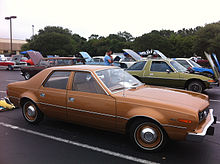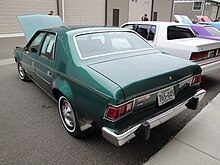AMC Hornet
With its manufacturer's suggested retail price (MSRP) of $1,994 for the base two-door model, the Hornet was a low-priced, economical small family car providing "cut-above interior appointments.
American Motors positioned the new line of sedans to be an American-designed small car that did not automatically stand for "cheap" by including features and conveniences that were optional to not available on competing brands, as well as making the Hornet wider on a longer wheelbase and with more body weight giving extra stability, increased ride comfort, better handling, interior room, trunk space, and enhanced security.
[34] The base Hornets "were nicely trimmed for the price" with standard armrests, ashtrays, interior lights, glove box, cigarette lighter, coat hooks, and an integrated dash ventilation system.
[34] The SST was available with two-tone paint, a black, white, or blue vinyl covered roof, as well as individually adjustable reclining front seats in upholstered in custom fabric with matching side trim and door panels.
[37] Popular Mechanics magazine road-tested an SST trim version with the V8 engine and automatic transmission and summarized the findings in the article's sub-title: "It has a lot of good things in a not-too-small package.
"[49] Hot Rod magazine ran the 1/4 mile an SC/360 with automatic transmission weighing 3,200 lb (1,451 kg) in 14.80 seconds at 94.63 mph in "bone-stock form" and predicted that high 13s could be achieved "with little more than a rejet and recurve of the carb and distributor.
[51] The muscle car market segment reached the height of popularity in 1970, but the combination of rising fuel and insurance prices along with emerging emissions reductions meant the end of an era.
The facelift incorporated a new stronger and larger energy-absorbing recoverable front bumper system with a horizontal rubber strip that met the new no-damage at 5 miles per hour (8.0 km/h) NHTSA safety legislation.
The new hatchback was available with Levi's bucket seat interior trim option that was made of spun nylon fabric, rather than real cotton denim, to comply with flammability standards as well as offer greater wear and stain resistance.
This trim package included exterior woodgrain bodyside decal panels, a roof rack with a rear air deflector, and individual reclining seats upholstered in plush cloth.
[81] American Motors' comprehensive "Buyer Protection Plan" warranty was expanded for the 1973 models to cover lodging expenses should a car require overnight repairs when the owner is away from home.
[84] A review by Popular Science of the 1974 cars and achieving fuel economy described the Hornet Sportabout as the only domestically built compact station wagon and they "give it our highest recommendation.
The initial VAM Rambler Americans were available in a single nameless trim level (equivalent to the U.S. SST models), with only an optional performance-minded "Rally" package for the two-door sedans that was carried over from 1969.
Dealership accessories included a universal 6000 RPM VDO tachometer with dual hands, vinyl-covered roof with additional bright moldings, heavy-duty suspension (front sway bar and stiffer adjustable shock absorbers), a floor-mounted shifter for the three-speed transmission, front disk brakes, locking gas cap, license plate frames, mud flaps, trunk cover luggage rack, universal air conditioning system, among others.
The 1973 model year VAM Hornets were redesigned and incorporated a new front-end design with larger horizontal rectangular side marker lights, semi-square headlight bezels, and a V-shaped grille and hood edge.
The difference in size and engine series between the Rambler American and the Gremlin was not enough for VAM to create the impression of a more solid and more diverse product line since both cars were perceived as belonging to the same economy class, which would produce internal competition.
The American base model in its first year was characterized by incorporating all-new rectangular amber parking lights, a grille divided into six squared portions, and more hexagonal-lined headlight bezels.
Both the 232 and 252 engine series were discontinued in favor of the higher-output 170 hp (127 kW; 172 PS), 8.5:1 compression ratio AMC 258 cu in (4.2 L) I6 with VAM's 266-degree camshaft and single-barrel Carter RBS or YF carburetor.
For the first time, a set of factory side stripes decorated the exterior of the model including a manuscript "Rally" emblem on the rear quarter panel, creating a two-tone appearance.
To avoid internal competition in both performance models as well as further pushing the line's concept change, VAM proceeded to upgrade the American Rally to differentiate it from the new subcompact version.
[110] The 1975 American ECD came standard with a 170 hp (127 kW; 172 PS) 258 cu in (4.2 L) I6 engine with a single-barrel Carter carburetor, electronic ignition, 266-degree camshaft, and 7.6:1 compression ratio with a regular cooling system.
Taking advantage of this upcoming new model was a plan of this group of employees to pay homage to VAM's general manager Gabriel Fernández Sáyago, one of the most respected men in the Mexican auto industry at the time and leader of the company since 1946.
The Hornet received a tune-up service in Caracas as well as in Lima, and the endurance record was promoted in various popular magazine advertisements for Champion spark plugs that were standard equipment in AMC engines.
[143] The Guinness World Records 2010 book describes this "revolutionary jump" as the "first astro spiral used in a movie" and lists it as third among the top ten James Bond film stunts.
"[165] The United States Environmental Protection Agency (EPA) conducted extensive tests of 1974 and 1975 AMC Hornets to evaluate the fuel economy claims made for the LaForce Ventur-E modifications.
[171] Work began by having the Jeep styling studio convert a Hornet into a pickup with three objectives: to compete in size with the imported trucks, rival the Chevrolet El Camino in appearance, and have a lower cost than both of them.
[170] One prototype vehicle that was painted red featured a modified AMC Gremlin front design and a cargo box with a Jeep logo on the tailgate, but did not include a four-wheel-drive system.
[172] A prototype finished in green and white was made using a Hornet SC/360 that featured the 360 cu in (5.9 L) V8 engine with a floor-mounted manual transmission, radio, air conditioning, and a drop-down tailgate with no manufacturer's name stamped on it.
[177] Using different designs on each side is common practice within automobile styling studios, especially when money was tight; however, showing such an example to the public was unusual and AMC was not afraid to measure consumer reaction to new ideas.
[178] Other design elements and ideas presented on the Hornet GT show car included sealed glass to allowing hollow doors that could house easily accessible components while freeing up space in the dashboard area, as well as a stronger roof and support pillars providing additional crash and rollover protection.























